英语祈使句详解
- 格式:pdf
- 大小:46.52 KB
- 文档页数:26
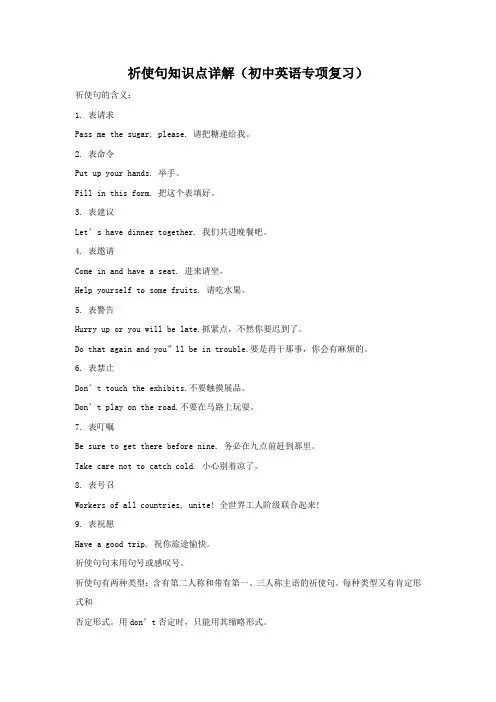
祈使句知识点详解(初中英语专项复习)祈使句的含义:1. 表请求Pass me the sugar, please. 请把糖递给我。
2. 表命令Put up your hands. 举手。
Fill in this form. 把这个表填好。
3. 表建议Let’s have dinner together. 我们共进晚餐吧。
4. 表邀请Come in and have a seat. 进来请坐。
Help yourself to some fruits. 请吃水果。
5. 表警告Hurry up or you will be late.抓紧点,不然你要迟到了。
Do that again and you”ll be in trouble.要是再干那事,你会有麻烦的。
6. 表禁止Don’t touch the exhibits.不要触摸展品。
Don’t play on the road.不要在马路上玩耍。
7. 表叮嘱Be sure to get there before nine. 务必在九点前赶到那里。
Take care not to catch cold. 小心别着凉了。
8. 表号召Workers of all countries, unite! 全世界工人阶级联合起来!9. 表祝愿Have a good trip. 祝你旅途愉快。
祈使句句末用句号或感叹号。
祈使句有两种类型:含有第二人称和带有第一、三人称主语的祈使句。
每种类型又有肯定形式和否定形式。
用don’t否定时,只能用其缩略形式。
例如:Welcome to Beijing Park.Walk about three blocks.Don’t mention it.无动词祈使句在请求、命令和口号中,常用无动词祈使句,它实际上是省略了动词,从而使语句更简洁或有力。
如:Just a minute, please! 请稍等!This way, please! 请这边走!Attention! 立正!Up the stairs! 上楼!To the playground, everyone of you! 到操场上去,你们每个人都得去!在一些指示牌上,常用“No +动名词/名词”构成简略式的否定祈使句。
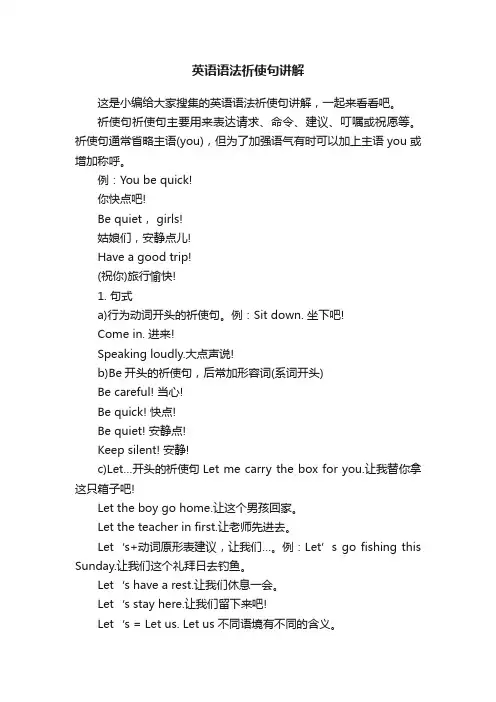
英语语法祈使句讲解这是小编给大家搜集的英语语法祈使句讲解,一起来看看吧。
祈使句祈使句主要用来表达请求、命令、建议、叮嘱或祝愿等。
祈使句通常省略主语(you),但为了加强语气有时可以加上主语you或增加称呼。
例:You be quick!你快点吧!Be quiet, girls!姑娘们,安静点儿!Have a good trip!(祝你)旅行愉快!1. 句式a)行为动词开头的祈使句。
例:Sit down. 坐下吧!Come in. 进来!Speaking loudly.大点声说!b)Be开头的祈使句,后常加形容词(系词开头)Be careful! 当心!Be quick! 快点!Be quiet! 安静点!Keep silent! 安静!c)Let…开头的祈使句Let me carry the box for you.让我替你拿这只箱子吧!Let the boy go home.让这个男孩回家。
Let the teacher in first.让老师先进去。
Let‘s+动词原形表建议,让我们…。
例:Let’s go fishing this Sunday.让我们这个礼拜日去钓鱼。
Let‘s have a rest.让我们休息一会。
Let‘s stay here.让我们留下来吧!Let‘s = Let us. Let us 不同语境有不同的含义。
Let‘s “请让我们(咱们…),包括谈话的对方。
”例:Let’s go out and play football.咱们出去踢足球吧!Let‘s have a rest!咱们休息一会吧!Let us 意为“请让我们……”表示希望得到对方允许,不包括对方。
Let us buy you a drink.给你买杯饮料吧!Let us go. (Don‘t stop us going.)请让我们走吧!2. 祈使句的否定式,在句首加don‘t,常用缩略式。
例:Don’t be late for school.上学别迟到。
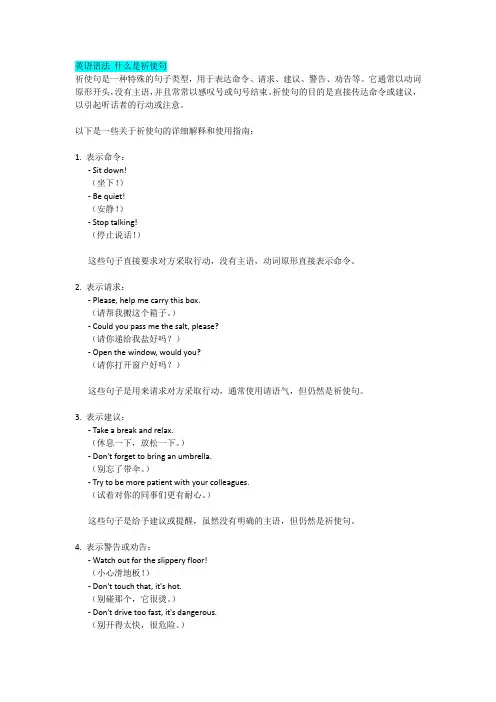
英语语法什么是祈使句祈使句是一种特殊的句子类型,用于表达命令、请求、建议、警告、劝告等。
它通常以动词原形开头,没有主语,并且常常以感叹号或句号结束。
祈使句的目的是直接传达命令或建议,以引起听话者的行动或注意。
以下是一些关于祈使句的详细解释和使用指南:1. 表示命令:- Sit down!(坐下!)- Be quiet!(安静!)- Stop talking!(停止说话!)这些句子直接要求对方采取行动,没有主语,动词原形直接表示命令。
2. 表示请求:- Please, help me carry this box.(请帮我搬这个箱子。
)- Could you pass me the salt, please?(请你递给我盐好吗?)- Open the window, would you?(请你打开窗户好吗?)这些句子是用来请求对方采取行动,通常使用请语气,但仍然是祈使句。
3. 表示建议:- Take a break and relax.(休息一下,放松一下。
)- Don't forget to bring an umbrella.(别忘了带伞。
)- Try to be more patient with your colleagues.(试着对你的同事们更有耐心。
)这些句子是给予建议或提醒,虽然没有明确的主语,但仍然是祈使句。
4. 表示警告或劝告:- Watch out for the slippery floor!(小心滑地板!)- Don't touch that, it's hot.(别碰那个,它很烫。
)- Don't drive too fast, it's dangerous.(别开得太快,很危险。
)这些句子是用来警告或劝告对方避免潜在的危险或错误。
祈使句的特点是直接、简洁和命令性。
它不包括任何主语,主要依靠动词原形来传达指令。
此外,祈使句通常用于口语和非正式的书面语境中,以更直接、简洁和有效地与对方沟通。
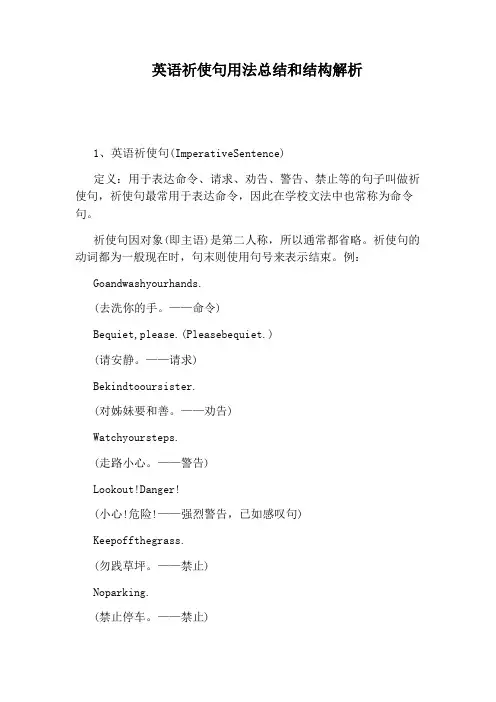
英语祈使句用法总结和结构解析1、英语祈使句(ImperativeSentence)定义:用于表达命令、请求、劝告、警告、禁止等的句子叫做祈使句,祈使句最常用于表达命令,因此在学校文法中也常称为命令句。
祈使句因对象(即主语)是第二人称,所以通常都省略。
祈使句的动词都为一般现在时,句末则使用句号来表示结束。
例:Goandwashyourhands.(去洗你的手。
——命令)Bequiet,please.(Pleasebequiet.)(请安静。
——请求)Bekindtooursister.(对姊妹要和善。
——劝告)Watchyoursteps.(走路小心。
——警告)Lookout!Danger!(小心!危险!——强烈警告,已如感叹句)Keepoffthegrass.(勿践草坪。
——禁止)Noparking.(禁止停车。
——禁止)祈使句也常把主语“You”表达出来,使对方听起来觉得柔和些,例如:Yougoandtellhim,Chris.(克立斯你去告诉他。
)2、相关口令祈使句无主语,主语you常省去;动词原形谓语当,句首加don't否定变;朗读应当用降调,句末常标感叹号。
●肯定结构:1.Do型(即:动词原形(+宾语)+其它成分)。
如:Pleasehaveaseathere.请这边坐。
有的祈使句在意思明确的情况下,动词可省略。
如:Thisway,please.=Gothisway,please.请这边走。
2.Be型(即:Be+表语(名词或形容词)+其它成分)。
如:Beagoodboy!要做一个好孩子!3.Let型(即:Let+宾语+动词原形+其它成分)。
如:Letmehelpyou.让我来帮你。
●否定结构:1.Do型和Be型的否定式都是在句首加don't构成。
如:Don'tforgetme!不要忘记我!Don'tbelateforschool!上学不要迟到!2.Let型的否定式有两种:“Don't+let+宾语+动词原形+其它成分”和“Let+宾语+not+动词原形+其它成分”。
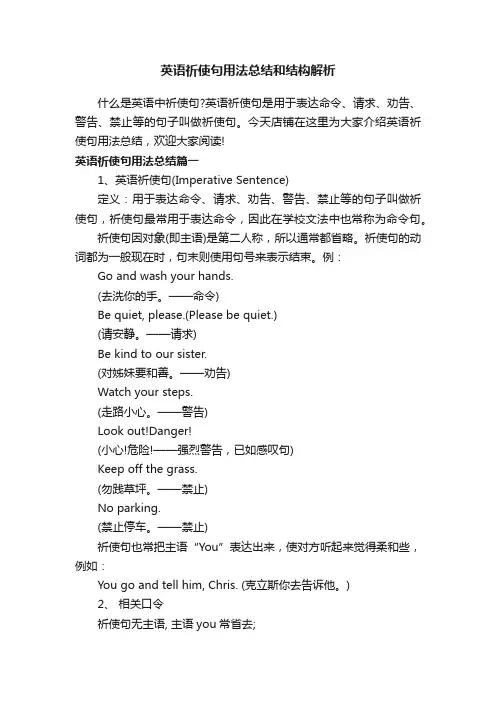
英语祈使句用法总结和结构解析什么是英语中祈使句?英语祈使句是用于表达命令、请求、劝告、警告、禁止等的句子叫做祈使句。
今天店铺在这里为大家介绍英语祈使句用法总结,欢迎大家阅读!英语祈使句用法总结篇一1、英语祈使句(Imperative Sentence)定义:用于表达命令、请求、劝告、警告、禁止等的句子叫做祈使句,祈使句最常用于表达命令,因此在学校文法中也常称为命令句。
祈使句因对象(即主语)是第二人称,所以通常都省略。
祈使句的动词都为一般现在时,句末则使用句号来表示结束。
例:Go and wash your hands.(去洗你的手。
——命令)Be quiet, please.(Please be quiet.)(请安静。
——请求)Be kind to our sister.(对姊妹要和善。
——劝告)Watch your steps.(走路小心。
——警告)Look out!Danger!(小心!危险!——强烈警告,已如感叹句)Keep off the grass.(勿践草坪。
——禁止)No parking.(禁止停车。
——禁止)祈使句也常把主语“You”表达出来,使对方听起来觉得柔和些,例如:You go and tell him, Chris. (克立斯你去告诉他。
)2、相关口令祈使句无主语, 主语you常省去;动词原形谓语当, 句首加don't否定变;朗读应当用降调, 句末常标感叹号。
英语祈使句用法总结篇二:表现形式●肯定结构:1. Do型(即:动词原形(+宾语)+其它成分)。
如:Please have a seat here. 请这边坐。
有的祈使句在意思明确的情况下,动词可省略。
如:This way, please. = Go this way, please. 请这边走。
2. Be型(即:Be + 表语(名词或形容词)+其它成分)。
如:Be a good boy! 要做一个好孩子!3. Let型(即:Let + 宾语 + 动词原形 + 其它成分)。
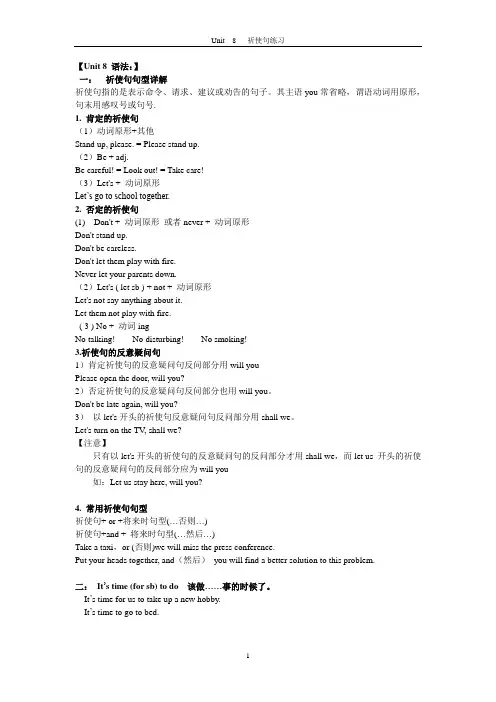
【Unit 8 语法:】一:祈使句句型详解祈使句指的是表示命令、请求、建议或劝告的句子。
其主语you常省略,谓语动词用原形,句末用感叹号或句号.1. 肯定的祈使句(1)动词原形+其他Stand up, please. = Please stand up.(2)Be + adj.Be careful! = Look out! = Take care!(3)Let's + 动词原形Let’s go to school together.2. 否定的祈使句(1) Don't + 动词原形或者never + 动词原形Don't stand up.Don't be careless.Don't let them play with fire.Never let your parents down.(2)Let's ( let sb ) + not + 动词原形Let's not say anything about it.Let them not play with fire.( 3 ) No + 动词ingNo talking! No disturbing! No smoking!3.祈使句的反意疑问句1)肯定祈使句的反意疑问句反问部分用will youPlease open the door, will you?2)否定祈使句的反意疑问句反问部分也用will you。
Don't be late again, will you?3)以let's开头的祈使句反意疑问句反问部分用shall we。
Let's turn on the TV, shall we?【注意】只有以let's开头的祈使句的反意疑问句的反问部分才用shall we,而let us 开头的祈使句的反意疑问句的反问部分应为will you如:Let us stay here, will you?4. 常用祈使句句型祈使句+ or +将来时句型(…否则…)祈使句+and + 将来时句型(…然后…)Take a taxi,or (否则)we will miss the press conference.Put your heads together, and(然后)you will find a better solution to this problem.二:It’s time (for sb) to do 该做……事的时候了。
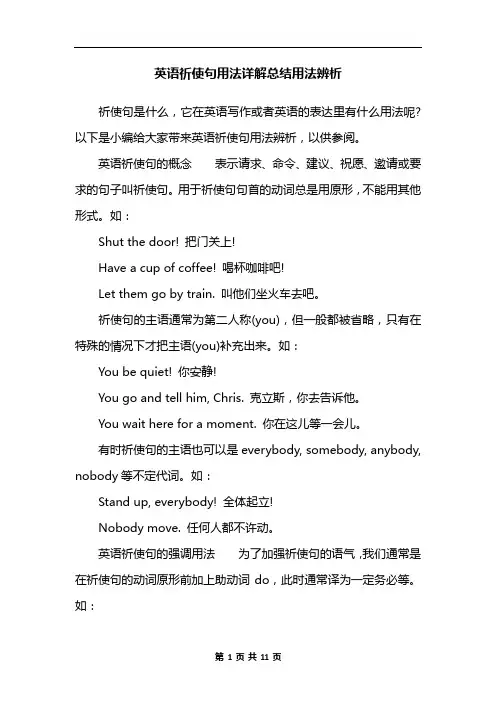
英语祈使句用法详解总结用法辨析祈使句是什么,它在英语写作或者英语的表达里有什么用法呢?以下是小编给大家带来英语祈使句用法辨析,以供参阅。
英语祈使句的概念表示请求、命令、建议、祝愿、邀请或要求的句子叫祈使句。
用于祈使句句首的动词总是用原形,不能用其他形式。
如:Shut the door! 把门关上!Have a cup of coffee! 喝杯咖啡吧!Let them go by train. 叫他们坐火车去吧。
祈使句的主语通常为第二人称(you),但一般都被省略,只有在特殊的情况下才把主语(you)补充出来。
如:You be quiet! 你安静!You go and tell him, Chris. 克立斯,你去告诉他。
You wait here for a moment. 你在这儿等一会儿。
有时祈使句的主语也可以是everybody, somebody, anybody, nobody等不定代词。
如:Stand up, everybody! 全体起立!Nobody move. 任何人都不许动。
英语祈使句的强调用法为了加强祈使句的语气,我们通常是在祈使句的动词原形前加上助动词do,此时通常译为一定务必等。
如:Do be careful. 务必要小心。
Do have some more tea. 一定再喝点茶。
Do let me go. 一定让我去。
副词never和always有时可用于祈使句句首,表示强调。
如:Never do that again. 再不要这样做了。
Always look in the mirror before starting to drive. 一定要先看看反光镜再开车。
英语祈使句的否定式用法构成祈使句否定式的方法很简单,那就是在动词原形前加dont不管祈使句所用的动词为什么性质动词,情况都是一样。
如:Open the window. 把窗户打开。
Dont open the window. 别把窗户打开。
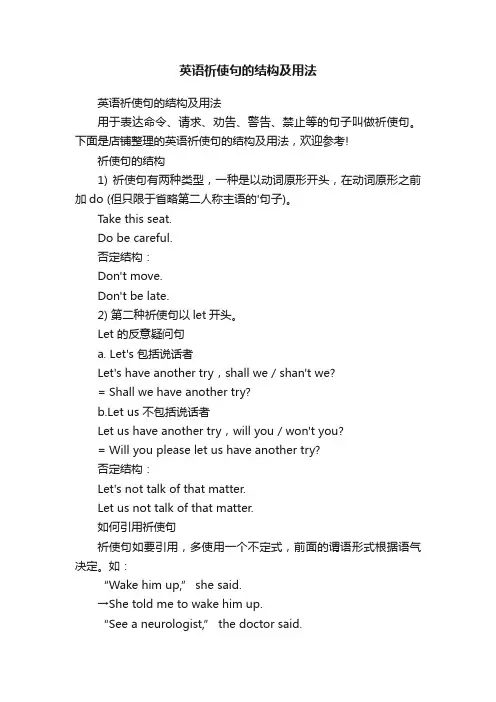
英语祈使句的结构及用法英语祈使句的结构及用法用于表达命令、请求、劝告、警告、禁止等的句子叫做祈使句。
下面是店铺整理的英语祈使句的结构及用法,欢迎参考!祈使句的结构1) 祈使句有两种类型,一种是以动词原形开头,在动词原形之前加do (但只限于省略第二人称主语的'句子)。
Take this seat.Do be careful.否定结构:Don't move.Don't be late.2) 第二种祈使句以let开头。
Let 的反意疑问句a. Let's 包括说话者Let's have another try,shall we / shan't we?= Shall we have another try?b.Let us 不包括说话者Let us have another try,will you / won't you?= Will you please let us have another try?否定结构:Let's not talk of that matter.Let us not talk of that matter.如何引用祈使句祈使句如要引用,多使用一个不定式,前面的谓语形式根据语气决定。
如:“Wake him up,” she said.→She told me to wake him up.“See a neurologist,” the doctor said.→The doctor advised me to see a neurologist.“Stay where you are and don’t move,” commanded the sergeant.→The sergeant commanded the man to stay where he was and not to move.“Carry the trunk upstairs,” Mr. Brown said.→Mr. Brown ordered the men to carry the trunk upstairs.能跟这种结构的动词有:advise ask beg command forbid instruct invite order,persuade remind teach tell urge warn祈使句的分类及例句1.祈使句构成方式:动词原形+其他。
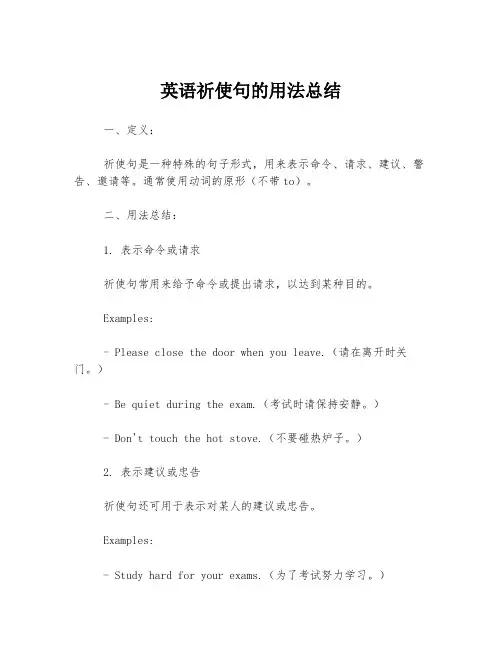
英语祈使句的用法总结一、定义:祈使句是一种特殊的句子形式,用来表示命令、请求、建议、警告、邀请等。
通常使用动词的原形(不带to)。
二、用法总结:1. 表示命令或请求祈使句常用来给予命令或提出请求,以达到某种目的。
Examples:- Please close the door when you leave.(请在离开时关门。
)- Be quiet during the exam.(考试时请保持安静。
)- Don't touch the hot stove.(不要碰热炉子。
)2. 表示建议或忠告祈使句还可用于表示对某人的建议或忠告。
Examples:- Study hard for your exams.(为了考试努力学习。
)- Be patient with your children.(对孩子有耐心。
)- Relax and enjoy your vacation.(放松,享受你的假期。
)3. 表示请求或邀请祈使句也常用来表示请求或邀请,以邀请别人一起做某事或请求别人给予帮助。
Examples:- Come to my party this Saturday.(这周六来参加我的派对。
)- Please help me with my homework.(请帮我做作业。
)- Join us for dinner tonight.(今晚和我们一起吃饭。
)4. 表示警告或劝告祈使句还可用于表示警告或劝告,以提醒某人注意某种潜在的危险或风险。
Examples:- Watch out for the slippery floor.(小心地板湿滑。
)- Don't forget to wear a seatbelt.(不要忘记系安全带。
)- Be careful with the sharp knife.(对锋利的刀子小心些。
)5. 表示祝愿或呼吁祈使句也可用于表示对某人或某物的祝愿或呼吁。

英语祈使句详解之五兆芳芳创作1.祈使句的概念暗示请求、命令、建议、祝愿、邀请或要求的句子叫祈使句.用于祈使句句首的动词总是用原形,不克不及用其他形式.如:Shut the door! 把门打开!Have a cup of coffee! 喝杯咖啡吧!Let them go by train. 叫他们坐火车去吧.祈使句的主语通常为第二人称(you),但一般都被省略,只有在特殊的情况下才把主语(you)弥补出来.如:You be quiet! 你宁静! You go and tell him, Chris. 克立斯,你去告知他. You wait here for a moment. 你在这儿等一会儿.有时祈使句的主语也可以是everybody, somebody, anybody, nobody等不定代词.如:Stand up, everybody! 全体起立!Nobody move. 任何人都禁绝动.2.祈使句暗示强调为了增强祈使句的语气,我们通常是在祈使句的动词原形前加上助动词do,此时通常译为“一定”“务必”等.如:Do be careful. 务需要小心.Do let me go. 一定让我去.副词never和always有时可用于祈使句句首,暗示强调.如:Never do that again. 再不要这样做了.Always look in the mirror before starting to drive. 一定要先看看反光镜再开车.3.祈使句的否认式组成祈使句否认式的办法很复杂,那就是在动词原形前加don’t——不管祈使句所用的动词为什么性质动词,情况都是一样.如:Open the window. 把窗户打开.→Don’t open the window. 别把窗户打开. Come next Monday. 下周星期一来.对于以let us或let’s开头的祈使句,其否认式通常是在不定式之前放一个not.如:Let’s tell him the truth. 我们把实情告知他吧.→Lets not tell him the truth. 我们不要把实情告知他.但在日常口语中,我们也可以把don’t放在let’s之前.如:Let’s don’t tell him the truth. 我们不要把实情告知他)4. 祈使句与连用please为了使祈使句的语气变得委婉,我们可以在祈使句的句首或句末加上please——若加在句首,其后不必逗号;若加在句末,则通常会在please前加一个逗号.如:Step this way, please. 请这边走.Please type your letter. 请把你的信打出来.Open the window, please. 请把窗户打开.如果是否认祈使句,则通常将please加在don’t之前.如: Please don’t get angry. 请不要生气.5.祈使句的时间概念祈使句所暗示的时间总是指未来,所以与它连用的句子原则上要用未来时态来与它照应.如:Give me a hand, will you? 帮我一个忙,好吗? 由于give me a hand暗示隐含未来意义,所以句中的will you 不克不及改成do you.Try again and you will succeed. 你再试就会成功. 由于句中的try again 隐含未来意义,所以句中用了you will succeed,而不是you succeed.Don’t do that again or you’ll be in trouble. 别再干那个了,不然你会有麻烦.句中的don’t do that again指的是以后不要再干那事了,由于隐含有未来意义,所以句中用了you’ll be in trouble,而没有用you are in trouble.6. 祈使句的省略一般说来,祈使句总是要以动词原形开头,但是,在某些特殊情况下,我们可以只用一个词或短语来暗示祈使句的意义.如:Just a few please. 请给几个就行了.A little more slowly please. 再慢一点.A pound of butter. 给我一磅黄油.Two teas and four coffees, please. 请来两杯茶和四杯咖啡.7.注意:祈使句什么时候可以保存主语you第1情况为了有所区分,祈使句可以保存主语you.如:You go on; I’ll wait. 你们先走,我等着.You wait here for a moment. 你在这儿等一会儿.You girls stand in the front row. 你们女孩子站在前排.You play Romeo and you play Juliet. 你演罗蜜欧,你演朱丽叶.You wait here, Jim, and Mary, you wait there. 你等在这儿,吉姆;玛丽,你等在那儿.第2种情况为了暗示生气或有意暗示无礼,祈使句可以保存主语you.如:You be quiet! 你给我宁静!You stop talking. 你给住嘴.You get out of here! 你给我滚出去. You do it right away. 你给我马上就去做.8.祈使句备考注意1. 祈使句主要用于提出请求,收回邀请,赐与指示、忠告或警告,也可收回命令等.2.祈使句的特点是:一般不出现主语(you),但有时为了指明向谁请求或命令,也可以说出主语;谓语动词一律用原形;否认式一律在动词前面加don’t.如:Come this way, madam. 这边走,夫人.Don’t lose the key. 别把钥匙丢了.Someone fetch a pail of water. 谁去打一桶水来.3.有关祈使句最可能涉及的考点是:祈使句带主语以及“祈使句+and / then/ or+陈述句”这一句型(祈使句暗示条件).另外,祈使句与反意疑问句一起考查也是高考一大特点.如:Let’s phone her now, shall we? 我们现在就给她打电话,好吗?You girls stand in the front row, will you? 你们女孩子站在前排,好吗?Work hard, and you’ll pass the exam. 努力点,你会通过考试的.9.没有动词的祈使句祈使句除用谓语动词暗示外,还可用名词、形容词、副词等,如:Help! 救人哟!Fire! 失火了!Patience! 要有耐心!Careful! 小心!Quickly! 快!Hands up! 举起手来!Good heavens! 天哪!10.“be+过来分词”用于祈使句be可以和少数过来分词连用,用于祈使句当中.如:Be prepared! 准备好! Please be seated! (请)坐下! Be warned! 该小心了!11. “be+形容词”用于祈使句只有暗示一时的行动的形容词才可用于be / don’t be之后,如careful / careless, patient / impatient, quiet, silly等(be / don’t be通常不成与指状态的形容词连用,如hungry / thirsty, pretty).如:Be quiet! 宁静点!Don’t be silly! 不要发傻!Do be patient. 一定要有耐心.Be careful about what you say. 说话要小心. Be more careful with your work. 你的任务要再细心一些.Be careful not to break anything. 当心别打破什么了.Be sure you don’t break any of them. 千万别把它们打破了.Be sure to write to ma as soon as you get there. 到了千万给我来信.Be sure and come as soon as possible. 一定要尽快来.Be sure to send out all the invitations today. 一定要在今天把请帖都收回去.12.“be+名词”用于祈使句许多“be (肯定式) +名词”结构是习习用法Be a man! 要做个男子汉! Be an angel and fetch me my slippers please. 请行行好,把我的拖鞋拿来.Go on! Have another slice! Be a devil! 持续吃呀! 再来一片! 铺开吃!否认式的“Don’t be+名词”结构要经常使用得多,往往与(愚蠢的)行动有关.如:Don’t be an ass / a clown / a fool / an idiot! 别当傻瓜/ 小丑/ 笨伯/ 痴人!请注意:“be+形容词+名词”结构:Be a good girl at sch001.Don’t be a silly idiot! 在学校你要做个好姑娘.别当个傻瓜!be可以暗示“成为”之义,尤其在告白中发.如:Be a better cook! Be the envy of your friends! 你可当个好厨师! 你可成为你的朋友们羡慕的对象!否认式d on’t be (=don’t become) 经常使用于劝告.如:Don’t be a racing driver! It’s So dangerous. 别当赛车运动员!太危险了.be还可以意谓“装作”,特别是用在you前面.如:(You) be the fairy godmother and I’ll be Cinderella. 你装仙姑,我装灰姑娘. Be a monster, granddad! 爷爷,你装个妖怪!要注意类似下面这样的用法:Now be yourself again! 现在可再显出你的赋性了!祈使句例题:1. The TV is too loud. Please________. A. turn it down B. to turn it downC. turn down itD. to turn down it2. _______ late again, Bill! A. Don't to be B. Don't be C. Not be D. Be not3. _______ cross the road until the traffic lights turn green. A. Not B. Won'tC. Doesn'tD. Don't4. Please help me carry it, ______? A. will I B. will you C. shall I D. shall we5. Don't make so much noise, ______? A. will you B. won't you C. shall we D.do you6. Do you know the girl ______under the tree? A. stand B. to stand C. standing D. stood7. Kate, _______ your homework here tomorrow. A. bring B. brings C. to bring D. bringing8. ________ me the truth, or I'll be angry. A. Telling B. To tell C. ToldD. Tell9. I've kept the dog _______Maomao for a long time. A. Name B. named C. naming D. to name10. Don't you know that _______ is good for our health? A. swim B. swimming C. swam D. swims11. _________ the milk and set a good example to the other children. A. DrinkB. To drinkC. DrinkingD. Having drinking12.________ me, and don’t just stand there laughing. A. Answer B. To answer C. Answering D. To be answering13. _________ me, and then try to copy what I do. A. Watch B. Watching C. To watch D. Have watching14._________ through this book and tell me what you think of it. A. Look B. Looking C. To look D. Having looked15._________ it with me and I’ll see what I can do. A. Leave B. Leavi ng C. If you leave D. When left16._________ down the radio —the baby’s asleep in the next room. A. TurningB. TurnC. TurnedD. To turn17._________ some of this juice — perhaps you will like it. A. Trying B. TryC. To tryD. Having tried18._________ left when you get to the end of the street. A. Keep B. Keeping C. To keep D. Kept19._________ you hand over your mouth when you cough. A. Put B. PuttingC. To putD. To be putting20._________ him enough time to get home before you telephone. A. Give B. To give C. Giving D. Given 21._________ until the lights have turned to green.A. WaitB. To waitC. WaitingD. Having waited22._________ the pieces of cloth with a loose stitch before finally sewing them together.A. JoinB. To joinC. JoiningD. Joined句型转换11. Will you please read it again more slowly? (改成祈使句)___ read __ __ it __ again more slowly, please. 12. If you don't listen to me, I'll go. (改成同义句)_____ _____ me, or I’ll go.13. Let's watch the sports games. (改成反意疑问句)Let's watch the sports games, _____ _____?14. The teachers often tell the students not to be careless. (改成祈使句)_____ _____careless, please.15. Please sit next to Nancy. (改成否认句)_____ _____ next to Nancy.16. Don't forget to turn off the lights, please. (改成反意疑问句)Don't forget to turn off the lights, _____ _____?17. If you move, you'll die. (改成同义句)_____ _____, or you'll die.18. Come to my house tomorrow. (改成反意疑问句)Come to my house tomorrow, _____ _____?19. 这是一个坏了的被子. (翻译句子)This is a ______ ______.20. 让我们去帮帮那个哭泣的女孩吧. (翻译句子)Let’s go and help the _____ _____, please.1-5. ABDBA 6-10. CADBB 11-15AAAAA 16-20BBAAA 21-22AA 11. Read it 12. Listen to 13. shall we 14. Don’t be 15. Don’t sit 16. will you 17. Don’t move 18. will / won’t you 19. broken glass / cup 20. crying girl。
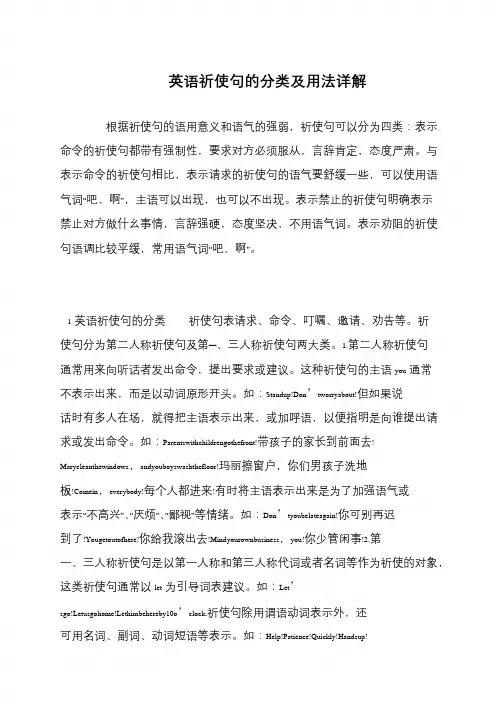
英语祈使句的分类及用法详解根据祈使句的语用意义和语气的强弱,祈使句可以分为四类:表示命令的祈使句都带有强制性,要求对方必须服从,言辞肯定,态度严肃。
与表示命令的祈使句相比,表示请求的祈使句的语气要舒缓一些,可以使用语气词“吧、啊”,主语可以出现,也可以不出现。
表示禁止的祈使句明确表示禁止对方做什幺事情,言辞强硬,态度坚决,不用语气词。
表示劝阻的祈使句语调比较平缓,常用语气词“吧、啊”。
1英语祈使句的分类祈使句表请求、命令、叮嘱、邀请、劝告等。
祈使句分为第二人称祈使句及第—、三人称祈使句两大类。
1.第二人称祈使句通常用来向听话者发出命令,提出要求或建议。
这种祈使句的主语you通常不表示出来,而是以动词原形开头。
如:Standup!Don’tworryabout!但如果说话时有多人在场,就得把主语表示出来,或加呼语,以便指明是向谁提出请求或发出命令。
如:Parentswithchildrengothefront!带孩子的家长到前面去! Marycleanthewindows,andyouboyswashthefloor!玛丽擦窗户,你们男孩子洗地板!Comein,everybody!每个人都进来!有时将主语表示出来是为了加强语气或表示“不高兴”、“厌烦”、“鄙视”等情绪。
如:Don’tyoubelateagain!你可别再迟到了!Yougetoutofhere!你给我滚出去!Mindyourownbusiness,you!你少管闲事!2.第一、三人称祈使句是以第一人称和第三人称代词或者名词等作为祈使的对象,这类祈使句通常以let为引导词表建议。
如:Let’sgo!Letusgohome!Lethimbehereby10o’clock.祈使句除用谓语动词表示外,还可用名词、副词、动词短语等表示。
如:Help!Patience!Quickly!Handsup!。
英语祈使句详解1. 祈使句的概念表示请求、命令、建议、祝愿、邀请或要求的句子叫祈使句;用于祈使句句首的动词总是用原形,不能用其他形式;如:Shut the door 把门关上Have a cup of coffee 喝杯咖啡吧Let them go by train. 叫他们坐火车去吧;祈使句的主语通常为第二人称you,但一般都被省略,只有在特殊的情况下才把主语you补充出来;如:You be quiet 你安静You go and tell him, Chris. 克立斯,你去告诉他;You wait here for a moment. 你在这儿等一会儿;有时祈使句的主语也可以是everybody, somebody, anybody, nobo dy等不定代词;如:Stand up, everybody 全体起立Nobody move. 任何人都不许动;2. 祈使句表示强调为了加强祈使句的语气,我们通常是在祈使句的动词原形前加上助动词do,此时通常译为“一定”“务必”等;如:Do be careful. 务必要小心;Do have some more tea. 一定再喝点茶;Do let me go. 一定让我去;副词never和always有时可用于祈使句句首,表示强调;如:Never do that again. 再不要这样做了;Always look in the mirror before starting to drive. 一定要先看看反光镜再开车;3. 祈使句的否定式构成祈使句否定式的方法很简单,那就是在动词原形前加don’t——不管祈使句所用的动词为什么性质动词,情况都是一样;如:Open the window. 把窗户打开;→Don’t open the window. 别把窗户打开;Come next Monday. 下周星期一来;→Don’t come next Monday. 下周星期一别来;对于以let us或let’s开头的祈使句,其否定式通常是在不定式之前放一个not;如:Let’s tell him the truth. 我们把实情告诉他吧;→Let’s not tell him the truth. 我们不要把实情告诉他;但在日常口语中,我们也可以把don’t放在let’s之前;如:Let’s don’t te ll him the truth. 我们不要把实情告诉他4. 祈使句与连用please为了使祈使句的语气变得委婉,我们可以在祈使句的句首或句末加上please——若加在句首,其后不用逗号;若加在句末,则通常会在plea se前加一个逗号;如:Step this way, please. 请这边走;Please type your letter. 请把你的信打出来;Open the window, please. 请把窗户打开;如果是否定祈使句,则通常将please加在don’t之前;如:Plea se don’t get angry. 请不要生气;Please don’t telephone before 8 a. m. 早8点以前请不要打电话;5. 祈使句的时间概念祈使句所表示的时间总是指将来,所以与它连用的句子原则上要用将来时态来与它呼应;如:Give me a hand, will you 帮我一个忙,好吗由于give me a hand表示隐含将来意义,所以句中的will you 不能改为do you;Try again and you will succeed. 你再试就会成功;由于句中的try again隐含将来意义,所以句中用了you will succ eed,而不是you succeed;Don’t do that again or you’ll be in trouble. 别再干那个了,否则你会有麻烦;句中的don’t do that again指的是以后不要再干那事了,由于隐含有将来意义,所所以句中用了you’ll be in trouble,而没有用you a re in trouble;6. 祈使句的省略一般说来,祈使句总是要以动词原形开头,但是,在某些特殊情况下,我们可以只用一个词或短语来表示祈使句的意义;如:Just a few please. 请给几个就行了;A little more slowly please. 再慢一点;A pound of butter. 给我一磅黄油;Two teas and four coffees, please. 请来两杯茶和四杯咖啡;助动词 do 在祈使句中的强调用法有时可在祈使句前加上助动词do 常重读,以表示说话人想特别强调他所说的话;这样用的祈使句具有以下用法:1. 表示强调的请求;如:Do come with us. 请一定要和我们一起去;Please Do be quiet a moment 求求你们安静一会儿2. 表示委婉或客气;如:Do try this fish. 请尝尝这鱼;Do have another cup of coffee. 请再喝杯咖啡吧;3. 表示不耐烦;如:Do stop talking 别说啦4. 希望说服对方;如:Do help me with this maths problem. 务请帮我解答这道数学题;someone和nobody等用作祈使句主语有时因为语义的需要,someone, nobody, everybody 等也可用作祈使句主语;如:Nobody say a word 都不许说话Someone fetch a pail of water. 谁去打一桶水来;Someone go and see who it is. 谁去看看是什么人来了;Somebody answer the phone please. 请来个人接电话;Everybody sit down and let’s have a drink. 大家坐下来喝一杯吧有时用作祈使句主语的还可以特定的某人;如:The boy in the corner come here. 在角落的那个男孩来这里吧这类句子有时也可以是否定的;如:Don’t anybody get out of here. 大家都别出去祈使句何时可以保留主语you祈使句的主语通常为第二人称you,但一般都被省略的;但以下两种情况可以保留主语you:第1情况为了有所区分,祈使句可以保留主语 you;如:You go on; I’ll wait. 你们先走,我等着;You wait here for a moment. 你在这儿等一会儿;You girls stand in the front row. 你们女孩子站在前排;You play Romeo and you play Juliet. 你演罗蜜欧,你演朱丽叶;You wait here, Jim, and Mary, you wait there. 你等在这儿,吉姆;玛丽,你等在那儿;第2种情况为了表示生气或有意表示无礼,祈使句可以保留主语 you;如:You be quiet 你给我安静You stop talking. 你给住嘴;You get out of here 你给我滚出去;You do it right away. 你给我马上就去做;let us 与let’slet us 的 us 既可指说话者一方此时表示请求或命令,也可以指说话者和听话者双方此时表示建议或劝诱,此用法在语体上较正式;而let’s 中的’s=us 则只能指说话者和听话者双方表示建议或劝诱,不能指说话者一方即不能用来表示命令或请求;比较:让我们告诉你我们在博物馆里看到的情况;误:Let’s tell you what we saw in the museum.正:Let us tell you what we saw in the museum.我们做朋友吧;正:Let’s be friends.较口语化正:Let us be friends.较正式在反意问句中,表示请求或命令时,用 will you;表示建议或劝诱时,用 shall we;如:我们一起去游泳好吗正:Let’s go swimming together, shall we 较口语化正:Let us go swimming together, shall we 较正式让我们跟你一起去好吗正:Let us go with you, will you误:Let’s go with you, will you shall welet’s 的否定式可以是let’s not, don’t let’s;如:Let’s not hurry. / Don’t let’s hurry. 我们不要太急;祈使句的动词可以是被动的吗有时可以,但比较少见;如:Don’t be fooled by his appearance. 不要为他的外表所欺骗了;Don’t be taken in by his promises. 别被他的诺言所欺骗;Don’t be stampeded into buying the house. 不要一时冲动买下这所房子;有时don’t 后接的“be+过去分词”不是被动式,而是系表结构;如:Don’t be discouraged. 不要气馁;祈使句备考注意1.祈使句主要用于提出请求,发出邀请,给予指示、忠告或警告,也可发出命令等;2.祈使句的特点是:一般不出现主语you,但有时为了指明向谁请求或命令,也可以说出主语;谓语动词一律用原形;否定式一律在动词前面加don’t;如:Come this way, madam. 这边走,夫人;Don’t lose the key. 别把钥匙丢了;Someone fetch a pail of water. 谁去打一桶水来;3.有关祈使句最可能涉及的考点是:祈使句带主语以及“祈使句+and / then / or+陈述句”这一句型祈使句表示条件;另外,祈使句与反意疑问句一起考查也是高考一大特点;如:Let’s phone her now, shall we 我们现在就给她打电话,好吗You girls stand in the front row, will you 你们女孩子站在前排,好吗Work hard, and you’ll pass the exam. 努力点,你会通过考试的;请做以下试题:1 Jim, you go there to help him, _______A. do youB. will youC. are youD. have you答案选B;句首的呼语 Jim 清楚地表明这一个祈使句,只是其前带了主语而已;2 ________ me back my money, or I’ll ring the police.A. GivingB. GivenC. GiveD. To give答案选C;填空处为祈使句谓语,故用动词原形;学习祈使句的几个基本要点一、祈使句的概念和一般形式表示请求、命令等的句子叫祈使句;它的主语是听话人you ,一般不需要说出来;通常以动词原形开头;祈使句末尾用惊叹号或句号,句子用降调;如:Open the door, please. 请把门打开;Be quiet, boys. 孩子们,安静点;Hurry up快点跟上;但有时为了指明向谁请求或发出命袋子令,也可说出主语来;如:Alice, you close your book. 艾丽期,请你把书关上;二、祈使句的否定式祈使句的否定式是在动词原形前加don’t;如:Don’t be late again. 不要再迟到了;Please don’t forget to take your medicine. 请不要忘记吃药;Don’t let’s quarrel about it. =Let’s not quarrel about it.我们不要为此事争吵了;三、祈使句的强调式Do be on time. 务必准时;Do come early. 务必早点来;四、区分let’s与let us /sb.Please let him in. 请让他进去;—Let’s go swimming, shall we我们去游泳,好吗—No, let’s not. /Yes, let’s. 不要去了;/我们去吧;—Let us go swimming, will you请你让我们去游泳,好吗—No, you’d better not. 你们最好别去;不要混淆祈使句与非谓语动词有这样一道语法考题,该用动词原形还是用非谓语动词_________ the road round to the right and you’ll find his h ouse.A. FollowB. FollowingC. To followD. Followed分析此题容易误选B或C,许多同学一看选项就想当然地认为,选现在分词表示时间或伴随,选不定式表目的;此题的关键是要注意句中的连词an d,它表明整个句子是一个并列句,即 and 前后应各是一个独立的句子,而不应是一个非谓语形式的短语,所以此题的正确答案应选A,即 and 前是一个祈使句;比较以下两题:1 _________ the road round to the right, she found his house.A. FollowB. FollowingC. To followD. Followed分析此题应选B,现在分词短语表时间;2 _________ the road round to the right, the blind man askeda boy to guide him.A. FollowB. FollowingC. To followD. Followed分析此题应选C,不定式短语表目的;注意以下各题均应选A,均因为句中的并列连词 and填空句为祈使句:1 _________ the milk and set a good example to the other chi ldren.A. DrinkB. To drinkC. DrinkingD. Having drinking2_________ me, and don’t just stand there laughing.A. AnswerB. To answerC. AnsweringD. To be answering3 _________ me , and then try to copy what I do.A. WatchB. WatchingC. To watchD. Have watching4 _________ through this book and tell me what you think of it.A. LookB. LookingC. To lookD. Having looked5_________ it with me and I’ll see what I can do.A. LeaveB. LeavingC. If you leaveD. When left注:有时可能不用连词,而用破折号答案均选B,填空句为祈使句;如:1 _________ down the radio —the baby’s asleep in the next room.A. TurningB. TurnC. TurnedD. To turn2 _________ some of this juice — perhaps you will like it.A. TryingB. TryC. To tryD. Having tried以下各题也应选A,是因为句中的从属连词 when, before, until 等填空句为祈使句:1 _________ left when you get to the end of the street.A. KeepB. KeepingC. To keepD. Kept2 _________ you hand over your mouth when you cough.A. PutB. PuttingC. To putD. To be putting3 _________ him enough time to get home before you telephone.A. GiveB. To giveC. GivingD. Given4_________ until the lights have turned to green.A. WaitB. To waitC. WaitingD. Having waited5 _________ the pieces of cloth with a loose stitch before f inally sewing them together.A. JoinB. To joinC. JoiningD. Joined以下各题也应选A,即填空句为祈使句:1Don’t give me a long account, just _________ the plain fa cts.A. tellB. tellingC. to tellD. to be telling2 First _________ the rice by washing it, then _________ it in boiling water.A. prepare, cookB. preparing, cookingC. prepa ring, cookD. prepare, cooking3Don’t sit there watching — _________ and help meA. comeB. comingC. to comeD. to be coming4Don’t waste your money on silly things — _________ it.A. saveB. to saveC. savingD. having saved5 To test eggs, _________ them in a bowl of water: if they f loat they’re bad, if they sink they’re good.A. putB. puttingC. to putD. to be putting但是,以下各题情形有所不同,所填部分为目的状语用不定式,即答案均为B:1 _________ late in the morning, Bob turned off the alarm.A. SleepB. To sleepC. SleepingD. Having slept2 _________ the early bus, Mr Smith got up at six.A. CatchB. To catchC. CatchingD. Having caught用复合不定代词作主语的祈使句■当要对一群人讲话时,祈使语气可与everybody, someone之类的词连用;如:Nobody move. 谁都别动;Nobody say a word 都不许说话Someone fetch a pail of water. 谁去打一桶水来;Somebody answer the phone please. 请来个人接电话;Someone go and see who it is. 谁去看看是什么人来了;Don’t anybody get out of here. 大家都别出去Everyone keep quiet 大家安静Everybody sit down and let’s have a drink. 大家坐下来喝一杯吧Mary, come here — everybody else stay where you are. 玛丽到这里来,其他人都留在原地;■在表示否定的命令语气后面可用带any的复合词:Don’t say a word anybody 谁都不要说话Don’t anybody say a word 任何人都不许说话以let开头的祈使句用法归纳■let后接第一人称Let’s have a look. 让我看一下;Let’s take a taxi 让我们坐出租车吧Let’s give you a hand. 让我帮助你;Let’s paint it ourselves. 我们自己来刷漆;Let’s take a taxi, shall we 我们坐出租车好吗Let’s start now and work till dark. 让我们现在开始工作一直到天黑;Let’s go shopping now. The shops will be / should be fairly empty. 我们去商店买东西吧;商店里人不会太多;Let me fix you a drink. 我给你去弄点饮料;Let me have a try. 我来试一试;Let me show you how to do it. 我来告诉你怎样做;Let me pay for myself. 让我自己来付我的那份钱;Let me have another cup of tea. 给我再来一杯茶;Let me know if you should hear some more news. 万一你听到更多消息你要通知我;■let后接第二人称较少见Let you and I try to make this all right. 让你和我试试把这个做好;■let后接第三人称Let her do what she likes. 让她做她想做的事吧;Let the meat cook slowly. 把肉用慢火炖;Let XYZ be a triangle. 设XYZ为一个三角形;Let the two lines be parallel. 假设两条线是平行的;Let every man do his best. 让每个人人尽其才;Let him have his own way. 让他照自己的意思做吧Let the true cause of the accident be published. 把造成这件意外的真正原因公开吧;Let h im try that game again on me, and I’ll soon put paid t o it. 他如若再和我玩这把戏,我很快就会叫他收起来;■let后接there be句式“Let there be no reprisals,” said the widow of the murdere d man. 被害者的遗孀说:“千万不要搞复仇;”Let there be light. 让地上有光;Let there be no doubt in your minds about our intentions. 对于我们的意图,你们心里不要有疑问;祈使句用法详解:表厌烦或为耐烦■典型例句Do be quiet. 安静点儿吧Stop probing 不要盘根问底了Speak quietly, can’t you 说话沉稳些,行不行Stop fiddling with that TV, will you 别摆弄那台电视机了,行不行祈使句用法详解:表警告或威胁■典型例句Don’t be rude. 不要无礼;Don’t you speak to me like that 你别这样跟我讲话Stir, and you are a dead man. 动一下就要你的命;Never speak to me like that again. 决不要再那个样子跟我说话;Put that down, or else I’ll smack you. 把它放下来,不然我会揍你;Do that again and I’ll call a policeman. 你再这样做我就要叫警察了;Fail to pay and they’ll cut off the electricity. 你如果不付款,他们就要断电;祈使句用法详解:表粗暴■典型例句Shut up 住口Push off 走开Get out 滚出去Get out of here 滚开Go to hell 见鬼去吧You get out of here 你给我滚出去;You take your hands off me 把你的手给我拿开祈使句用法详解:表祝愿■典型例句Have fun 愿你玩得快活Have a good time 祝你玩得开心Have a good day 祝你度过美好的一天Have a really good meal 愿你享受一顿美餐Have a lovely party 愿你有一次愉快的聚会Have a really restful holiday 愿你度过一次十分悠闲的休假Have a really interesting debate 愿你们有一次十分有趣的辩论祈使句用法详解:表邀请■典型例句Have a cup of coffee 喝杯咖啡吧Mary, play on my side. 玛丽,你和我一伙玩吧;Come and have dinner with us soon. 一会儿来跟我们一起吃饭吧;Go on Have another slice Be a devil 继续吃呀再来一片放开吃祈使句用法详解:表禁止■典型例句Keep off the grass 请勿践踏草地Do not touch these wires. 请勿接触电线Do not feed the animals 不许给动物扔食物Do not feed the lions. 请勿向狮子投喂食物祈使句用法详解:表指引■典型例句Walk to the corner, turn right and cross the road. 走到那个拐角,然后向右拐穿过马路;Go straight on and you’ll see a church. 径直往前走,你会看到一座教堂;Take the 2nd turning on the left and then turn right. 在第二个拐角处向左,然后再向右拐;祈使句用法详解:表告诫■典型例句Beware of the dog 当心狗Beware of pickpockets. 小心扒手;Look out Mind your head 小心当心头Take care not to catch cold. 小心别着凉;Look out There’s a bus 当心有公共汽车Always keeps to your promise. 一定要遵守诺言;Remember to switch off all the lights. 记着把所有的灯关掉;Do not use this spray neat a naked flame. 别在火焰附近使用这种喷射剂;Always look in the mirror before starting to drive. 一定要先看看反光镜再开车;Be there on time otherwise you’ll create a bad impression 要准时来,否则你会给人一个坏的印象;有不少否定的祈使句用于表示告诫:Don’t panic 别慌fromDon’t lose the key. 别把钥匙丢了;D on’t ever do that again. 别再这样做了;Don’t tell anybody, will you 不要告诉任何人,好吗尤其要注意一些以 Never 开头的祈使句;如:Never say die. 不要气馁Never speak to strangers 不要跟陌生人说话Never do that again. 再不要这样做了;Never ask her about her marriage. 决不要问她结婚的事;Never buy expensive clothes. 决不要买贵重的衣裳;Never touch an electric wire when it is broken. 绝不要动断了的电线;Never trouble trouble till trouble troubles you. 不要无事惹事;Never hold a gun by the business end. 拿枪千万别拿枪口那端;Never identity opinions with facts. 绝不要把意见和事实等同起来;Never put off till tomorrow what you can do today. 今日事,今日毕;Never leave a silk shirt to the tender mercies of an automat ic washing-machine. 切勿用自动洗衣机洗绸衬衫;Never pay the advertised price for a car; always try to barg ain. 千万不要照牌价购买汽车,总得讲讲价才是;祈使句用法详解:表叮嘱■典型例句Fasten your seat belt. 系好安全带;Be sure to get here before nine. 千万要在九点以前到;Stay in bed for a couple of days. 卧床休息几天;Take care of yourselves. 你们要注意身体啊Look over what you’ve written before handing it to the exam iner. 先把你写的看一遍,再交给考官;Cross the road very carefully. Look both ways, or you might be knocked down. 过马路要非常小心,要看两边,不然会被车撞倒;祈使句用法详解:表建议■典型例句Get your hair cut 你去理发吧Get your eyes tested 你去检查一下你的眼睛吧Ask Jake, not his wife. 去问杰克,不要问他妻子;Come early, but not before six. 早点来,但别在6点以前;Go off for the weekend, why don’t you 去度周末,好吗Have a bath and a rest and you’ll feel better. 洗个澡,休息一下,你就会觉得好些;Cancel the match if it rains. If it rains, cancel the match.如果下雨,就取消比赛吧;Take a taxi, otherwise you’ll miss your train. 你如不叫出租汽车,你就会误掉火车的;You try teaching 40 noisy children five days a week 你来试试每周5天教40个吵闹的孩子注:以let’s开头的祈使句通常表示建议;如:Let’s go to the cinema tonight. 今晚咱们去看电影;Let’s get down to work. 咱们干起来吧from ;祈使句用法详解:表请求■典型例句Give me a hand, will you 帮我一个忙,好吗Please help me for a few minutes. 请帮我几分钟;Please remember me to Mr. Smith. 请帮我向史密斯先生致意;Do forgive me I didn’t mean to be rude. 务请原谅,我无心对你粗鲁无礼;Be an angel and fetch me my slippers please. 请行行好,把我的拖鞋拿来;Please don’t telephone before 8 a. m. 早8点以前请不要打电话;Hand me the hammer, will you 把锤子递给我好吗Do be quiet, for God’s sake 看在上帝的份上,安静一会儿吧Give me some bread as well, please. 请你也给我一点儿面包吧;Bring the fruit up to the dining room, will you把水果送到楼上餐厅里来好吗I’ll try on a few of these shirts. Please pass me that whit e one. 我要试穿几件衬衣,请把那件白色的递给我from ;祈使句用法详解:表命令■典型例句Hands off 不要摸Go there right away. 马上去那儿;Nobody move. 任何人都不许动;Stand over there. 站到那边去;Drop that gun, or I’ll shoot you. 放下枪,不然我就打死你;如何引用祈使句祈使句如要引用,多使用一个不定式,前面的谓语形式根据语气决定;如:“Wake him up,” she said.→She told me to wake him up.“See a neurologist,” the doctor said.→The doctor advised me to see a neurologist.“Stay where you are and don’t move,” commanded the sergea nt.→The sergeant commanded the man to stay where he was and no t to move.“Carry the trunk upstairs,” Mr. Brown said.→Mr. Brown ordered the men to carry the trunk upstairs.■能跟这种结构的动词有:advise ask beg command fo rbid instruct invite orderpersuade remind teach tell urge warn没有动词的祈使句祈使句除用谓语动词表示外,还可用名词、形容词、副词等,如:Help 救人哟Fire 失火了Patience 要有耐心Careful 小心Quickly 快Hands up 举起手来Good heavens 天哪“be+过去分词”用于祈使句be可以和少数过去分词连用,用于祈使句当中;如:Be prepared 准备好Please be seated 请坐下Be warned 该小心了试比较:Get washed 去洗一洗注:祈使句偶尔也用进行式,即 be 后接现在分词;如:Be listening to this station at the same time tomorrow night.请于明晚同一时间听本台的广播;“be+形容词”用于祈使句只有表示一时的行为的形容词才可用于be / don’t be之后,如care ful / careless, patient / impatient, quiet, silly等be / don’t be通常不可与指状态的形容词连用,如hungry / thirsty, pretty;如:Be quiet 安静点Don’t be silly 不要发傻Do be patient. 一定要有耐心;Be careful about what you say. 说话要小心;Be more careful with your work. 你的工作要再细心一些;Be careful not to break anything. 当心别打破什么了;Be sure you don’t break any of them. 千万别把它们打破了;Be sure to write to ma as soon as you get there. 到了千万给我来信;Be sure and come as soon as possible. 一定要尽快来;Be sure to send out all the invitations today. 一定要在今天把请帖都发出去;注意有关的回答:Be quiet 别说话→否定的回答:I won’t 我不嘛Don’t be so impatient 别这么着急→否定的回答:I’m not 我不着急“be+名词”用于祈使句■许多“be 肯定式 +名词”结构是习惯用法Be a man 要做个男子汉Be an angel and fetch me my slippers please. 请行行好,把我的拖鞋拿来;Go on Have another slice Be a devil 继续吃呀再来一片放开吃■否定式的“Don’t be+名词”结构要常用得多,往往与愚蠢的行为有关;如:Don’t be an ass / a clown / a fool / an idiot 别当傻瓜 / 小丑 / 笨蛋 / 白痴■请注意:“be+形容词+名词”结构:Be a good girl at ’t be a silly idiot 在学校你要做个好姑娘;别当个傻瓜■be可以表示“成为”之义,尤其在广告中发;如:Be a better cook Be the envy of your friends 你可当个好厨师你可成为你的朋友们羡慕的对象■否定式don’t be =don’t become 常用于劝告;如:Don’t be a racing driver It’s So dangerous. 别当赛车运动员太危险了;■be还可以意谓“装作”,特别是用在you后面;如:You be the fairy godmother and I’ll be Cinderella. 你装仙姑,我装灰姑娘;Be a monster, granddad 爷爷,你装个妖怪■要注意类似下面这样的用法:Now be yourself again 现在可再显出你的本色了对特定的人使用的祈使句祈使句如Wait here 在这儿等着可以是对一个人说,也可以是对几个人说,其主语暗含you;但我们却可以用下列方式引起我们说话的对象的注意:■You+祈使语气动词You wait here for a moment. 你在这儿等一会儿;语调和重音很重要;在上面这一句里,如果不重读you, 那么句子的意思是this is where you wait 这就是你应等着的地方;如果重读you,那么句子的意思就是this is what I want you to do 这是我要你做的事;此外,重读you时还可以表示愤怒、敌意或不客气;如:You mind your own business 不关你什么事fromYou try teaching 40 noisy children five days a week 你来试试每周5天教40个吵闹的孩子在否定句中Don’t要重读不重读you;如:Don’t you speak to me like that 你别这样跟我讲话■“you+人名”或“人名+you”You wait here, Jim, and Mary, you wait there. 你等在这儿,吉姆;玛丽,你等在那儿;■“祈使语气+人名”或“人名+祈使语气”:Drink up your milk, Sally 把你的牛奶喝光,萨利Sally, drink up your milk 萨利,把你的牛奶喝光■祈使语气+反身代词Enjoy yourself. 你好好享受吧;Behave yourself. 你放规矩点;■对一群人讲话时,祈使语气可与everybody, someone之类的词连用:Everyone keep quiet 大家安静Keep still everybody 每个人都保持不动Nobody say a word 都不许说话Somebody answer the phone please. 请来个人接电话;■在表示否定的命令语气后面可用带any的复合词Don’t say a word anybody 谁都不要说话Don’t anybody say a word 任何人都不许说话是考查祈使句还是非谓语动词请看下面这道题,是考查祈使句还是考查非谓语动词_______ the road round to the right and you’ll find his hou se.A. FollowB. FollowingC. To followD. Followed分析正确答案选A;根据句中的连词and 可推知它是一个并列句;假若将此题改为下面这样,则答案为B:_______ the road round to the right, you’ll find his house.A. FollowB. FollowingC. To followD. Followed但是,若改成下面一题这样,则答案为C不定式短语表目的:_______ the road round to the right, the blind man asked a b oy to guide him.A. FollowB. FollowingC. To followD. Followed请做以下试题,答案均选A,都是因为句中的并列连词 and填空句为祈使句:1 _______ to the top of the hill, and you can see the whole of the town.A. GetB. To getC. GettingD. Having got2 ______ the milk and set a good example to the other childr en.A. DrinkB. To drinkC. DrinkingD. Having drinking3 ______ me, and then try to copy what I do.A. WatchB. WatchingC. To watchD. Have watching4 _____ through this book and tell me what you think of it.A. LookB. LookingC. To lookD. Having looked5 _____ it with me and I’ll see what I can do.A. LeaveB. LeavingC. If you leaveD. When left有时不用连词连接句子,而用破折号,情况也是一样答案均选A;如:6 _____ down the radio —the baby’s asleep in the next roo m.A. TurnB. TurningC. to turnD. To have turned7 _____ some of this juice — perhaps you will like it.A. TryB. TryingC. To tryD. To have tried以下各题也应选A,是因为句中的从属连词 when, before, until 等填空句为祈使句:8 ______ him enough time to get home before you telephone.A. GiveB. To giveC. GivingD. Given9 ______ left when you get to the end of the street.A. KeepB. KeepingC. To keepD. Kept10 ______ your hand over your mouth when you cough.A. PutB. PuttingC. To putD. To be putting11______ until the lights have turned to green.A. WaitB. To waitC. WaitingD. Having waited12 ______ the pieces of cloth with a loose stitch before fin ally sewing them together.A. JoinB. To joinC. JoiningD. Joined以下各题也应选A,因为填空句为祈使句from :13 I don’t want to listen a long story — just _____ me the result.A. tellB. tellingC. to tellD. to be telling14 Why stand there watching — _____ and help usA. comeB. comingC. to comeD. to be coming15 Don’t waste your money on silly things — ______ it.A. saveB. to saveC. savingD. having saved16 First ______ the rice by washing it, then ______ it in bo iling water.A. prepare, cookB. preparing, cookingC. preparing, cookD. prepare, cooking。
英语中的祈使句的用法祈使句那可太好玩儿啦!一、祈使句的基本概念。
祈使句就像是一个指挥官在发号施令。
它主要是用来表达请求、命令、劝告、警告或者建议啥的。
简单说呢,就是直接告诉你别人要做或者不要做某事。
比如说“Close the door(关门)”,这就是直接命令你去关门。
二、肯定形式的祈使句。
1. 结构简单。
- 一般就是动词原形开头。
像“Stand up(站起来)”“Sit down(坐下)”,就这么直接,没有那些啰里吧嗦的主语(在祈使句里,主语you常常是省略的,因为说话双方都知道是在对“你”或者“你们”说话)。
2. 可以加些礼貌词。
- 如果想要礼貌一点呢,可以在前面加个“please”。
比如“Please pass me the book(请把书递给我)”。
这个“please”可神奇啦,加了它,命令的感觉就柔和了很多,变成了有礼貌的请求。
三、否定形式的祈使句。
1. 基本结构。
- 否定形式就是在动词原形前面加“Don't”。
比如说“Don't run(别跑)”,这就是告诉你不要做“跑”这个动作。
要是你在图书馆里横冲直撞,管理员可能就会这么跟你说。
2. 特殊情况。
- 还有些比较特殊的,像“Never”也可以用来表示否定的祈使。
“Never give up(永不放弃)”,这就比“Don't give up”语气更强烈一点,有一种很坚决的感觉。
四、祈使句的一些特殊用法。
1. Let型祈使句。
- 这种祈使句以“Let”开头。
如果是“Let me(让我)”,那就是自己请求做某事,比如“Let me have a try(让我试一试)”。
要是“Let's”呢,就是“让我们”,表示建议大家一起做某事,像“Let's go shopping(让我们去购物吧)”。
这就像是你拉着小伙伴一起去玩的感觉。
2. 祈使句的语气强弱。
- 祈使句的语气可强可弱。
如果是大声喊“Stop(停)”,那就是很强烈的命令,可能是在紧急情况下。
英语祈使句释义
英语祈使句(Imperative Sentences)是一种用于表达命令、请求、建议、劝告或愿望的句型。
这种句子的主语通常被省略,因为祈使句的目的是直接向听话者传达一种行为或动作。
祈使句以动词原形开头,表示一种强烈的语气,要求或希望听话者执行某个动作。
例如:
命令和请求:
1.“Close the door.”(关门。
)
2.“Please pass me the salt.”(请把盐递给我。
)
建议和劝告:
1.“Have a good rest.”(好好休息。
)
2.“Don't forget to call your mom.”(别忘了给你妈妈打电话。
)
愿望:
1.“Long live peace!”(和平万岁!)
请注意,为了礼貌起见,我们经常在祈使句前加上“please”,使其听起来更像一个请求而非命令。
同时,我们也可以调整语气和措辞,以使祈使句在特定场合下更为合适。
在书面语中,为了明确表示是谁应当执行动作,有时还会加上主语,如:“You close the door.”(你关门。
)。
初中英语――祈使句祈使句指的是表示命令、请求、建议或劝告的句子。
其主语you常省略,谓语动词用原形,句末用感叹号或句号,读降调。
1. 肯定的祈使句(1)动词原形+其他Stand up, please. = Please stand up. 请起立。
(2)Be + adj.Be careful! = Look out! = Take care! 小心/ 当心!(3)Let's + 动词原形Let’s go to school together. 咱们一起上学去吧。
2. 否定的祈使句(1) Don't + 动词原形Don't stand up. 别站起来。
Don't be careless. 别粗心。
Don't let them play with fire. 别让他们玩火。
(2)Let's ( let sb ) + not + 动词原形Let's not say anything about it. 对于这件事,咱们什么也别说。
Let them not play with fire. 别让他们玩火。
3.祈使句的反意疑问句(1) 肯定祈使句的反意疑问句反问部分用will you 或won't you。
Please open the door, will/ won’t you? 请把门打开,好吗(2) 否定祈使句的反意疑问句反问部分只用will you。
Don't be late again, will you? 别再迟到了,行不行(3) 以let's开头的祈使句反意疑问句反问部分用shall we。
Let's turn on the TV, shall we? 我们把电视打开,好吗<特别注意> 只有以let's开头的祈使句的反意疑问句的反问部分才用shall we,而let us 开头的祈使句的反意疑问句的反问部分应为will you或won't you.如:Let us stay here, will/ won't you? 请(你)让我们留在这好吗语法练兵场单项选择1. The TV is too loud. Please________.A. turn it downB. to turn it downC. turn down itD. to turn down it2. _______ late again, Bill!A. Don't to beB. Don't beC. Not beD. Be not3. _______ cross the road until the traffic lights turn green.A. NotB. Won'tC. Doesn'tD. Don't4. Please help me carry it, ______?A. will IB. will youC. shall ID. shall we5. Don't make so much noise, ______?A. will youB. won't youC. shall weD. do you6. Do you know the girl ______under the tree?A. standB. to standC. standingD. stood7. Kate, _______ your homework here tomorrow.A. bringB. bringsC. to bringD. bringing8. ________ me the truth, or I'll be angry.A. TellingB. To tellC. ToldD. Tell9. I've kept the dog _______Maomao for a long time.A. NameB. namedC. namingD. to name10. Don't you know that _______ is good for our health?A. swimB. swimmingC. swamD. swims?句型转换11. Will you please read it again more slowly? (改为祈使句)___ read __ __ it __ again more slowly, please.12. If you don't listen to me, I'll go. (改为同义句)_____ _____ me, or I’ll go.13. Let's watch the sports games. (改为反意疑问句)Let's watch the sports games, _____ _____?14. The teachers often tell the students not to be careless. (改为祈使句)_____ _____careless, please.15. Please sit next to Nancy. (改为否定句)_____ _____ next to Nancy.16. Don't forget to turn off the lights, please. (改为反意疑问句)Don't forget to turn off the lights, _____ _____?17. If you move, you'll die. (改为同义句)_____ _____, or you'll die.18. Come to my house tomorrow. (改为反意疑问句)Come to my house tomorrow, _____ _____?19. 这是一个坏了的被子。
英语祈使句详解1.祈使句的概念表示请求、命令、建议、祝愿、邀请或要求的句子叫祈使句。
用于祈使句句首的动词总是用原形,不能用其他形式。
如:Shut the door! 把门关上! Have a cup of coffee! 喝杯咖啡吧!Let them go by train. 叫他们坐火车去吧。
祈使句的主语通常为第二人称(you),但一般都被省略,只有在特殊的情况下才把主语(you)补充出来。
如:You be quiet! 你安静! You go and tell him, Chris. 克立斯,你去告诉他。
You wait here for a moment. 你在这儿等一会儿。
有时祈使句的主语也可以是everybody, somebody, anybody, nobody等不定代词。
如:Stand up, everybody! 全体起立!Nobody move. 任何人都不许动。
2.祈使句表示强调为了加强祈使句的语气,我们通常是在祈使句的动词原形前加上助动词do,此时通常译为“一定”“务必”等。
如:Do be careful. 务必要小心。
Do let me go. 一定让我去。
副词never和always有时可用于祈使句句首,表示强调。
如:Never do that again. 再不要这样做了。
Always look in the mirror before starting to drive. 一定要先看看反光镜再开车。
3.祈使句的否定式构成祈使句否定式的方法很简单,那就是在动词原形前加don’t——不管祈使句所用的动词为什么性质动词,情况都是一样。
如:Open the window. 把窗户打开。
→Don’t open the window. 别把窗户打开。
Come next Monday. 下周星期一来。
对于以let us或let’s开头的祈使句,其否定式通常是在不定式之前放一个not。
英语祈使句详解1. 祈使句的概念表示请求、命令、建议、祝愿、邀请或要求的句子叫祈使句。
用于祈使句句首的动词总是用原形,不能用其他形式。
如:Shut the door! 把门关上!Have a cup of coffee! 喝杯咖啡吧!Let them go by train. 叫他们坐火车去吧。
祈使句的主语通常为第二人称(you),但一般都被省略,只有在特殊的情况下才把主语(you)补充出来。
如:You be quiet! 你安静!You go and tell him, Chris. 克立斯,你去告诉他。
You wait here for a moment. 你在这儿等一会儿。
有时祈使句的主语也可以是everybody, somebody, anybody, nobody等不定代词。
如:Stand up, everybody! 全体起立!Nobody move. 任何人都不许动。
2. 祈使句表示强调为了加强祈使句的语气,我们通常是在祈使句的动词原形前加上助动词d务必”等。
如:o,此时通常译为“一定”“Do be careful. 务必要小心。
Do have some more tea. 一定再喝点茶。
Do let me go. 一定让我去。
副词never和always有时可用于祈使句句首,表示强调。
如:Never do that again. 再不要这样做了。
Always look in the mirror before starting to drive. 一定要先看看反光镜再开车。
3. 祈使句的否定式构成祈使句否定式的方法很简单,那就是在动词原形前加don’t——不管祈使句所用的动词为什么性质动词,情况都是一样。
如:Open the window. 把窗户打开。
→Don’t open the window. 别把窗户打开。
Come next Monday. 下周星期一来。
→Don’t come next Monday. 下周星期一别来。
对于以let us或let’s开头的祈使句,其否定式通常是在不定式之前放一个not。
如:Let’s tell him the truth. 我们把实情告诉他吧。
→Let’s not tell him the truth. 我们不要把实情告诉他。
但在日常口语中,我们也可以把don’t放在let’s之前。
如:Let’s don’t tell him the truth. 我们不要把实情告诉他)4. 祈使句与连用please为了使祈使句的语气变得委婉,我们可以在祈使句的句首或句末加上pleas e——若加在句首,其后不用逗号;若加在句末,则通常会在please前加一个逗号。
如:Step this way, please. 请这边走。
Please type your letter. 请把你的信打出来。
Open the window, please. 请把窗户打开。
如果是否定祈使句,则通常将please加在don’t之前。
如:Please don’t get angry. 请不要生气。
Please don’t telephone before 8 a. m. 早8点以前请不要打电话。
5. 祈使句的时间概念祈使句所表示的时间总是指将来,所以与它连用的句子原则上要用将来时态来与它呼应。
如:Give me a hand, will you? 帮我一个忙,好吗?由于give me a hand表示隐含将来意义,所以句中的will you 不能改为d o you。
Try again and you will succeed. 你再试就会成功。
由于句中的try again隐含将来意义,所以句中用了you will succeed,而不是you succeed。
Don’t do that again or you’ll be in trouble. 别再干那个了,否则你会有麻烦。
句中的don’t do that again指的是以后不要再干那事了,由于隐含有将来意义,所所以句中用了you’ll be in trouble,而没有用you are in trouble。
6. 祈使句的省略一般说来,祈使句总是要以动词原形开头,但是,在某些特殊情况下,我们可以只用一个词或短语来表示祈使句的意义。
如:Just a few please. 请给几个就行了。
A little more slowly please. 再慢一点。
A pound of butter. 给我一磅黄油。
Two teas and four coffees, please. 请来两杯茶和四杯咖啡。
助动词do 在祈使句中的强调用法有时可在祈使句前加上助动词do (常重读),以表示说话人想特别强调他所说的话。
这样用的祈使句具有以下用法:1. 表示强调的请求。
如:Do come with us. 请一定要和我们一起去。
Please! Do be quiet a moment! 求求你们! 安静一会儿!2. 表示委婉或客气。
如:Do try this fish. 请尝尝这鱼。
Do have another cup of coffee. 请再喝杯咖啡吧。
3. 表示不耐烦。
如:Do stop talking! 别说啦!4. 希望说服对方。
如:Do help me with this maths problem. 务请帮我解答这道数学题。
someone和nobody等用作祈使句主语有时因为语义的需要,someone, nobody, everybody 等也可用作祈使句主语。
如:Nobody say a word! 都不许说话!Someone fetch a pail of water. 谁去打一桶水来。
Someone go and see who it is. 谁去看看是什么人来了。
Somebody answer the phone please. 请来个人接电话。
Everybody sit down and let’s have a drink. 大家坐下来喝一杯吧!有时用作祈使句主语的还可以特定的某人。
如:The boy in the corner come here. 在角落的那个男孩来这里吧!这类句子有时也可以是否定的。
如:Don’t a nybody get out of here. 大家都别出去!祈使句何时可以保留主语you祈使句的主语通常为第二人称(you),但一般都被省略的。
但以下两种情况可以保留主语you:第1情况为了有所区分,祈使句可以保留主语you。
如:You go on; I’ll wait. 你们先走,我等着。
You wait here for a moment. 你在这儿等一会儿。
You girls stand in the front row. 你们女孩子站在前排。
You play Romeo and you play Juliet. 你演罗蜜欧,你演朱丽叶。
You wait here, Jim, and Mary, you wait there. 你等在这儿,吉姆;玛丽,你等在那儿。
第2种情况为了表示生气或有意表示无礼,祈使句可以保留主语you。
如:You be quiet! 你给我安静!You stop talking. 你给住嘴。
You get out of here! 你给我滚出去。
You do it right away. 你给我马上就去做。
let us 与let’slet us 的us 既可指说话者一方(此时表示请求或命令),也可以指说话者和听话者双方(此时表示建议或劝诱,此用法在语体上较正式);而let’s 中的’s(=us) 则只能指说话者和听话者双方(表示建议或劝诱),不能指说话者一方(即不能用来表示命令或请求)。
比较:让我们告诉你我们在博物馆里看到的情况。
误:Let’s tell you what we saw in the museum.正:Let us tell you what we saw in the museum.我们做朋友吧。
正:Let’s be friends.(较口语化)正:Let us be friends.(较正式)在反意问句中,表示请求或命令时,用will you;表示建议或劝诱时,用s hall we。
如:我们一起去游泳好吗?正:Let’s go swimming together, shall we?(较口语化)正:Let us go swimming together, shall we?(较正式)让我们跟你一起去好吗?正:Let us go with you, will you?误:Let’s go with you, will you [shall we]?。
如:not, don’t let’s的否定式可以是let’slet’shurry. 我们不要太急。
Let’s not hurry. / Don’t let’s祈使句的动词可以是被动的吗]有时可以,但比较少见。
如:Don’t b e fooled by his appearance. 不要为他的外表所欺骗了。
Don’t b e taken in by his promises. 别被他的诺言所欺骗。
Don’t b e stampeded into buying the house. 不要一时冲动买下这所房子。
有时don’t 后接的“be+过去分词”不是被动式,而是系表结构。
如:Don’t b e discouraged. 不要气馁。
祈使句备考注意1.祈使句主要用于提出请求,发出邀请,给予指示、忠告或警告,也可发出命令等。
2.祈使句的特点是:一般不出现主语(you),但有时为了指明向谁请求或命。
令,也可以说出主语;谓语动词一律用原形;否定式一律在动词前面加don’t如:Come this way, madam. 这边走,夫人。
Don’t l ose the key. 别把钥匙丢了。
Someone fetch a pail of water. 谁去打一桶水来。
3.有关祈使句最可能涉及的考点是:祈使句带主语以及“祈使句+and / the n / or+陈述句”这一句型(祈使句表示条件)。
另外,祈使句与反意疑问句一起考查也是高考一大特点。
如:Let’s phone her now, shall we? 我们现在就给她打电话,好吗?You girls stand in the front row, will you? 你们女孩子站在前排,好吗?Work hard, and you’ll pass the exam. 努力点,你会通过考试的。
请做以下试题:(1) Jim, you go there to help him, _______?A. do youB. will youC. are youD. have you答案选B。